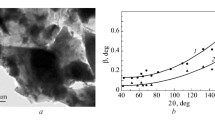Abstract
The grain boundary structure of barium titanate obtained by controlled-rate sintering and high-pressure sintering (HPS), and the dependence of dielectric properties on grain size and consolidation method were studied. It was shown that sintering without the application of pressure leads to a diffusion-controlled formation of equilibrium grain boundaries with minimal impedance factor, which minimally decrease the dielectric constant of the ceramics. HPS results in the formation of non-equilibrium grain boundaries which have a large free volume, and which substantially decrease the dielectric constant. The Curie-Weiss constant was analyzed from the viewpoint of a matrix structural model, and a «brick-wall» model.
Similar content being viewed by others
References
G. Arlt, D. Hennings, and G. DeWith, “Dielectric properties of fine-grained barium titanate ceramics,” J. Appl. Phys.,58,No. 4, 1619-1625 (1985).
X. Li and W. H. Shih, “Size effect in barium titanate particles and clusters,” J. Amer. Ceram. Soc., 80,No. 11, 2844-2852 (1997).
K. Uchino, E. Sadanaga, and T. Hirose, “Dependence of crystal structure on particle size in barium titanate,” J. Amer.Ceram. Soc., 72,No. 8, 1555-1558 (1989).
B. D. Begg, E. R. Vance, and J. Nowotny, “Effect of particle size on the room-temperature crystal structure of barium titanate,” J. Amer. Ceram. Soc., 77,No. 12, 3186-3192 (1994).
E. K. Akdogan, W. Mayo, A. Safari, et al., “Structure-property relations in mesoscopic BaTiO3 and PbTiO3,”Ferroelectrics, 223, 11-18 (1999).
Y. G. Wang, W. L. Zhong, and P. L. Zhang, “Size driven transition in ferroelectric particles,” Solid State Comm., 90,No. 5, 329-332 (1994).
M. H. Frey, “Grain size effect on structure and properties for chemically prepared barium titanate,” Ph.D. Thesis, University of Illinois at Urbana-Champaign, 1996.
D. McCauley, R. E. Newnham, and C. A. Randall, “Intrinsic size effect in a barium titanate glass ceramic,” J. Amer. Ceram. Soc., 81, No.4, 979-987 (1998).
J. C. Niepce, “Some aspects of the influence of particle size on properties and behavior of dielectric material: Example of barium titanate,” in: Surface and Interface of Ceramic Materials, L. C. Dufour, C. Monty, and G. Petot-Ervas (eds.), Kluwer, Dordrecht, 1989. NATO-ASI Series, Series E: Applied Sciences, 173, 521-533.
T. Takeuchi, K. Ado, T. Asia, et al., “Thickness of cubic surface phase on barium titanate single-crystal grains,” J. Amer. Ceram. Soc., 77,No. 6, 1665-1668 (1994).
D. A. Payne and L. E. Cross, “Microstructure-property relations for dielectric ceramics. II. The brick-wall model of the polycrystalline microstructure,” in: Microstructure and Properties of Ceramic Materials, T. S. Yen and J. A. Pask (eds.), Beijing Science Press, 1984.
M. P. McNeal, S. J. Jang, and R. E. Newnham, “The effect of grain and particle size on the microwave properties of barium titanate (BaTiO3),” J. Appl. Phys., 83,No.3, 3288-3297 (1998).
W. Y. Shih, W. H. Shih, and I. A. Aksay, “Size dependence of the ferroelectric transition of small BaTiO3 particles: effect of depolarization,” Phys. Rev. B, 50,No. 21, 15575-15585 (1994).
R. Waser, “Grain boundaries —the functional heart of electronic ceramics,” in: Third Euro-Ceramics, P. Duran and J. F. Fernandes (eds.), Vol. 2 (1998), pp.23-28.
A. I. Bykov, A. V. Polotai, A. V. Ragulya, and V. V. Skorokhod, “Synthesis and sintering of nanocrystalline barium titanate powder under non-isothermal conditions. V. Non-isothermal sintering of barium titanium powders of various dispersions,” Poroshk. Metall., Nos. 7-8, 88-98 (2000).
A. V. Ragulya, O. O. Vasyl'kiv, and V. V. Skorokhod, “Synthesis and sintering of nanocrystalline barium titanate powder under non-isothermal conditions. I. Controlling the degree of dispersion of barium titanate during its synthesis from barium-titanium oxalate,” Poroshk. Metall., Nos. 3-4, 59-65 (1997).
O. O. Vasyl'kiv, A. V. Ragulya, and V. V. Skorokhod, “Synthesis and sintering of nanocrystalline barium titanate powder under non-isothermal conditions. II. Phase analysis of decomposition products for barium titanyl-oxalate and synthesis products for barium titanate,” Poroshk. Metall., Nos. 5-6, 53-59 (1997).
O. O. Vasyl'kiv, A. V. Ragulya, V. P. Klimenko, and V. V. Skorokhod, “Synthesis and sintering of nanocrystalline barium titanate powder under non-isothermal conditions. III. Chromatographic analysis of the decomposition products of barium titanyl-oxalate,” Poroshk. Metall., Nos. 11-12, 11-15 (1997).
A. V. Ragulya, O. O. Vasyl'kiv, and V. V. Skorokhod, “Synthesis and sintering of nanocrystalline barium titanate powder under non-isothermal conditions. IV. Electron microscopic study of the morphological evolution of barium titanate powder,” Poroshk. Metall., Nos. 3-4, 12-20 (1998).
A. V. Ragulya, “Rate controlled synthesis and sintering of nanocrystalline barium titanate powder,” Nanocrystalline Mater., 10,No. 3, 349-356 (1998).
H. Jang, D. Frakas, J. T. M. De Hosson, “Determination of grain-boundary geometry using TEM,” J. Mater. Res., 7,No. 7, 1707-1717 (1992).
O. A. Kaibyshev and R. Z. Valiev, Grain Boundaries and Properties of Metals [in Russian], Metallurgiya, Moscow (1987).
H. Gleiter, “Nanostructured materials: basic concept and microstructure,” Acta Mater., 48, 1-29 (2000).
Y. Ishida, H. Ichinosi, T. Kizuka, and K. Suenaga, “High-resolution electron microscopy of interfaces in nanocrystalline materials,” Nanostructured Mater., 6,No. 1-4, 115-124 (1995).
P. Mullner and W. M. Kriven, “On the role of deformation twinning in domain reorganization and grain reorientation in ferroelastic crystals,” J. Mater. Res., 12,No. 7, 1771-1776 (1997).
Q. Tan and D. Viehland, “Influence of thermal and elastic histories on domain structure and polarization switching in potassium-modified lead zirconate titanate ceramics,” J. Amer. Ceram. Soc., 81,No. 2, 328-336 (1998).
K. Kinoshita and A. Yamaji, “Grain size effects on dielectric properties in barium titanate ceramics,” J. Appl. Phys., 47, 371-379 (1976).
M. H. Frey and D. A. Payne, “Grain size effect on structure and phase transformations of barium titanate,” Phys. Rev. B, 54, 3158-3168 (1996).
V. V. Skorokhod, “Theory of physical properties,” Poroshk. Metall., Nos. 1-2, 53-71 (1995).
Author information
Authors and Affiliations
Rights and permissions
About this article
Cite this article
Ragulya, A.V., Skorokhod, V.V. Synthesis and Sintering of Nanocrystalline Barium Titanate Powder under Non-Isothermal Conditions. Part 6. Structure, Grain Boundaries, and Dielectric Properties of Barium Titanate Obtained by Various Sintering Methods. Powder Metallurgy and Metal Ceramics 40, 25–33 (2001). https://doi.org/10.1023/A:1011347519938
Issue Date:
DOI: https://doi.org/10.1023/A:1011347519938



